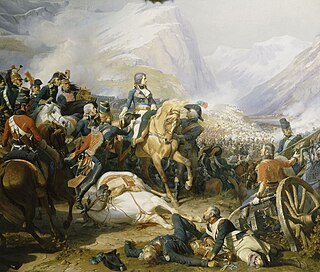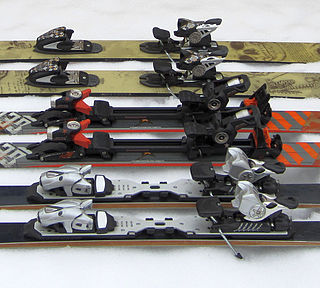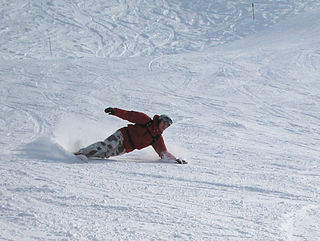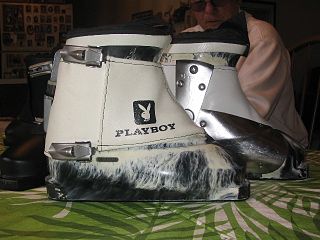Related Research Articles

Snowboards are boards where the user places both feet, usually secured, to the same board. The board itself is wider than most skis, with the ability to glide on snow. Snowboards widths are between 6 and 12 inches or 15 to 30 centimeters. Snowboards are differentiated from monoskis by the stance of the user. In monoskiing, the user stands with feet inline with direction of travel, whereas in snowboarding, users stand with feet transverse to the longitude of the board. Users of such equipment may be referred to as snowboarders. Commercial snowboards generally require extra equipment, such as bindings and special boots which help secure both feet of a snowboarder, who generally ride in an upright position. These types of boards are commonly used by people at ski hills, mountains, backcountry, or resorts for leisure, entertainment, and competitive purposes in the activity called snowboarding.
Skis are runners, attached to the user's feet, designed to glide over snow. Typically employed in pairs, skis are attached to ski boots with ski bindings, with either a free, lockable, or partially secured heel. For climbing slopes, ski skins can be affixed to the base of each ski to prevent them from sliding backwards. Originally used as a means of travel over snow, skis have become specialized for recreational and competitive alpine and cross-country skiing.

Snowboarding is a recreational and competitive activity that involves descending a snow-covered surface while standing on a snowboard that is almost always attached to a rider's feet. It features in the Winter Olympic Games and Winter Paralympic Games.

Alpine skiing, or downhill skiing, is the pastime of sliding down snow-covered slopes on skis with fixed-heel bindings, unlike other types of skiing, which use skis with free-heel bindings. Whether for recreation or for sport, it is typically practiced at ski resorts, which provide such services as ski lifts, artificial snow making, snow grooming, restaurants, and ski patrol.

Snowshoes are specialized outdoor gear for walking over snow. Their large footprint spreads the user's weight out and allows them to travel largely on top of rather than through snow. Adjustable bindings attach them to appropriate winter footwear.

The Battle of Rivoli was a key military engagement during the War of the First Coalition near the village of Rivoli, then part of the Republic of Venice. In the climax of the Italian campaign of 1796-1797, the outnumbered French Army of Italy commanded by General Napoleon Bonaparte decisively defeated the attacking Austrian army commanded by General of the Artillery Jozsef Alvinczi, who was attempting to march south in a fourth and final attempt to relieve the siege of Mantua. The French victory at Rivoli further demonstrated Bonaparte's capability and deftness as a military commander, and led to the Austrian surrender of Mantua in February, French consolidation of northern Italy, and ultimately France's victory over Austria in the war later that year.

Skiing, or traveling over snow on skis, has a history of at least eight millennia. The earliest archaeological examples of skis were found in Karelia and date to 6000 BCE. Although skiing's origins were purely utilitarian, the modern sport evolved from beginnings in Scandinavia. In the mid-1800s skiing became a popular recreational activity and sport. In the 20th century it was practiced in snow-covered regions worldwide, providing a market for the development of ski resorts and their related communities.

Telemark skiing is a skiing technique that combines elements of Alpine and Nordic skiing, using the rear foot to keep balance while pushing on the front foot to create a carving turn on downhill skis with toe-only bindings. Telemark skiing is named after the Telemark region of Norway, where the discipline originated. Sondre Norheim is often credited for first demonstrating the turn in ski races, which included cross country, slalom, and jumping, in Norway around 1868. Sondre Norheim also experimented with ski and binding design, introducing side cuts to skis and heel bindings.

A ski binding is a device that connects a ski boot to the ski. Before the 1933 invention of ski lifts, skiers went uphill and down and cross-country on the same gear. As ski lifts became more prevalent, skis—and their bindings—became increasingly specialized, differentiated between alpine (downhill) and Nordic styles of skiing. Until the point of divergence in the mid-20th century, bindings held the toe of a flexible, leather boot against the ski and allowed the heel to rise off the ski, typically with a form of strap or cable around the heel.
The parallel turn in alpine skiing is a method for turning which rolls the ski onto one edge, allowing it to bend into an arc. Thus bent, the ski follows the turn without sliding. It contrasts with earlier techniques such as the stem Christie, which slides the ski outward from the body ("stemming") to generate sideways force. Parallel turns generate much less friction and are more efficient both in maintaining speed and minimizing skier effort.
Ski boots are footwear used in skiing to provide a way to attach the skier to skis using ski bindings. The ski/boot/binding combination is used to effectively transmit control inputs from the skier's legs to the snow.

Elbert Leander "Burt" Rutan is a retired American aerospace engineer and entrepreneur noted for his originality in designing light, strong, unusual-looking, and energy-efficient air and space craft. He designed the record-breaking Voyager, which in 1986 was the first plane to fly around the world without stopping or refueling. He also designed the Virgin Atlantic GlobalFlyer, which in 2006 set the world record for the fastest and longest nonstop non-refueled circumnavigation flight in history. In 2004, Rutan's sub-orbital spaceplane design SpaceShipOne became the first privately funded spacecraft to enter the realm of space, winning the Ansari X-Prize that year for achieving the feat twice within a two-week period.
Three Days of the Condor is a 1975 American political thriller film directed by Sydney Pollack and starring Robert Redford, Faye Dunaway, Cliff Robertson, and Max von Sydow. The screenplay by Lorenzo Semple Jr. and David Rayfiel was based on the 1974 novel Six Days of the Condor by James Grady.

A skwal is the main piece of equipment used for skwalling, a hybrid sport combining the carving of skiing and riding feel of snowboarding. It is similar to a snowboard or monoski in that both feet are attached to the same board. On a skwal the feet are one in front of the other, in line with the direction the skwal is pointing in. This differs from snowboards and monoskis.
Burton Snowboards is a privately-owned snowboard manufacturing company that was founded by Jake Burton Carpenter in 1977. The company specializes in products aimed at snowboarders, such as snowboards, bindings, boots, outerwear, and accessories. The company, whose flagship store is in Burlington, Vermont, was privately owned by Jake Burton Carpenter, until his death in 2019, and by his wife, Donna Carpenter, who has been active in the business since 1983.
Marker International is a German manufacturing company of equipment for winter sports established in 1952 and headquartered in Straubing, Lower Bavaria. Founded by Hannes Marker, the company is known for pioneering releasable binding technology. Marker's first model, the Duplex was followed in 1953 by the Simplex toe binding which was a huge success in the 1950s. New models introduced in the 1980s were major competitors on the alpine racing circuit.

Jean Raoul Célina André Vuarnet was an alpine ski racer from France. An Olympic gold medalist, he is known for inventing the "Tuck" skiing position, and was the first Olympian to win a gold medal using metal skis. Raised in Morzine, he had a childhood interest in skiing, which he pursued. He won a bronze medal in the downhill at the World Championships in 1958 at Bad Gastein, before winning gold in the same event in the 1960 Winter Olympics in Squaw Valley. Vuarnet was also the author of several books on skiing. He gave his name to the Vuarnet brand in 1961. In 1995, his wife Edith Bonlieu, a fellow Olympian, and their son Patrick both died in a mass murder-suicide of members of the Order of the Solar Temple.

Look's Nevada, released in 1950, was the first recognizably modern alpine ski binding. The Nevada was only the toe portion of the binding, and was used with a conventional cable binding for the heel. An updated version was introduced in 1962 with a new step-in heel binding, the Grand Prix. These basic mechanisms formed the basis for LOOK bindings for over 40 years, changing mainly in name and construction materials. The Nevada toe pattern is almost universal among bindings today.

Rosemount Ski Boots introduced one of the earliest all-plastic ski boots for the downhill skiing market, competing with Bob Lange for the title of "first". Rosemount's design was easily distinguished by its use of the uncommon "side-entry" method for putting the boot on, which was rare at the time and is no longer used.
This glossary of skiing and snowboarding terms is a list of definitions of terms and jargon used in skiing, snowboarding, and related winter sports.
References
- ↑ Wright, Wesley Alan. "The University of Vermont: SKIVT-L: Ski Vermont Discussion List: Vermont Skiing Rules : Vermont Ski History Vault: Movie, Photos, Maps :". waw.w3.uvm.edu. Retrieved 2020-03-22.